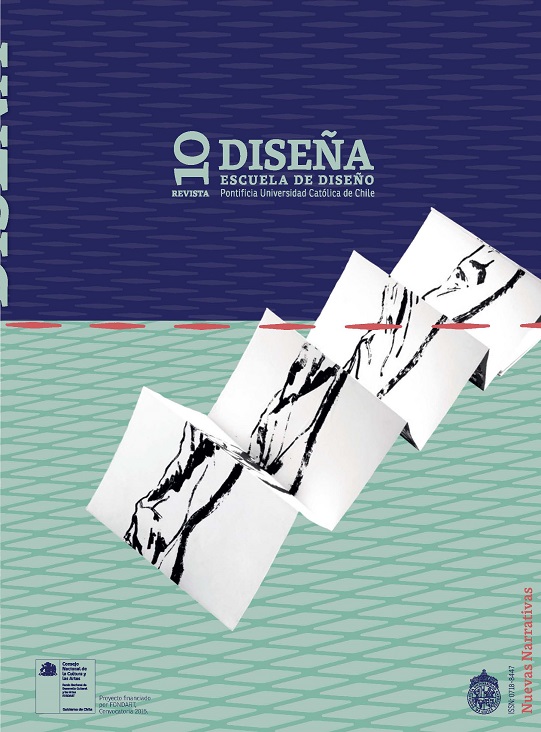Nobody is Safe
Main Article Content
Abstract
This article is a reedition of some aspects addressed previously for a thesis dissertation, work that concentrated around the historic and subjective narratives about death. In the first part it presents information on the theoretical framework of the thesis and the characterization of the four stages through which the attitude of the European person towards death has gone through, from the Middle Ages until today, according to historian of mentalities Philippe Ariès. In the second part the project is set out and the context, the strategy, the graphic guidelines and the functioning are described. The project, entitled “Nobody is safe”, evaluated with maximum honours, seeks to deliver information, testimonies, interpretations and actions of artistic nature that can bring people closer to a taboo subject: death.
Downloads
Article Details

This work is licensed under a Creative Commons Attribution-ShareAlike 4.0 International license.
COPYRIGHT NOTICE
All contents of this electronic edition are distributed under the Creative Commons license of "Attribution-ShareAlike 4.0 Internacional" (CC-BY-SA). Any total or partial reproduction of the material must mention its origin.
The rights of the published images belong to their authors, who grant to Diseña the license for its use. The management of the permits and the authorization of the publication of the images (or of any material) that contains copyright and its consequent rights of reproduction in this publication is the sole responsibility of the authors of the articles.
References
Ariès, P. (1987). El hombre ante la muerte. Madrid: Taurus.
Ariès, P. (2000). Historia de la muerte en Occidente. Desde la Edad Media hasta nuestros días. Barcelona: El Acantilado.
Asociación de consumidores de asistencia mortuoria (s.f.). Principales procedimientos médico-administrativos (Documento informativo). Obtenido de Asistenca Mortuoria: www.asistenciamortuoria.cl/ documentos/PRINCIPALES%20 PROCEDIMIENTOS.pdf
Azpeitia Martín, M. (2008). Historiografía de la “Historia de La Muerte”. Studia Historica, Historia Medieval, 26, 113-132 (disponible en http://www.redalyc.org/ pdf/3675/367539032006.pdf).
Cáceres, M. D., Brändle, G., & Ruiz San Román, J. A. (2013). Comunicación interpersonal en la web 2.0. Las relaciones de los jóvenes con desconocidos. Revista Latina de Comunicación Social(68), 436-456.
ComScore (20 de septiembre de 2011). El crecimiento de las redes sociales en América Latina. Obtenido de ComScore: http://www.comscore.com/ esl/Prensa-y-Eventos/ Presentaciones-y-libros-blancos/2011/The-Rise-of- Social-Networking-in-Latin- America?cs_edgescape_cc=CL
Death Café (s. f.). What is Death Cafe? Recuperado el 2 de junio de 2016, de Death Cafe: http:// deathcafe.com/what/
El País (10 de diciembre de 1982). La OMS considera necesidad imperiosa la definición legal de la muerte. El País, pág. http:// elpais.com/diario/1982/12/10/ sociedad/408322808_850215.html.
Herrera, F. (25 de enero de 2012). Tendencias del usuario digital chileno en 2012. Obtenido de IAB Chile : http://www.iab.cl/ estudios-iab/page/11/
Huizinga, J. (2005). El otoño de la Edad Media. Madrid: Alianza.
Instituto de Sociología PUC. (2013). IV estudio Los chilenos y la muerte. Facultad de Ciencias Sociales, Pontificia Universidad Católica de Chile.
Jiménez Aboitiz, R. (2012). ¿De la muerte (de)negada a la muerte reivindicada? Análisis de la muerte en la sociedad española actual: muerte sufrida, muerte vivida y discursos sobre la muerte (Tesis doctoral). Universidad de Valladolid.
Mellafe, R. (1982). Historia de las mentalidades: Una nueva alternativa. Santiago: Universidad de Chile.
Moody, R. (1997). Vida después de la vida. Madrid: Edaf.
Ríos, J. (24 de marzo de 2015). Analépticos: fármacos estimulantes del sistema nervioso central. Recuperado el 31 de mayo de 2016, de Prezi: https://prezi.com/stmwbihz08j7/ analepticos-farmacos-estimulantes-del-sistema-nervioso-cent/
Urmeneta, A. (2001). El afrontamiento de la muerte a través de la historia. Obtenido de Derecho a morir dignamente: www.eutanasia.ws/hemeroteca/ t169.pdf
Visión Humana (2012). Estudio los chilenos y la muerte (tercera versión, Resumen Ejecutivo).
Vovelle, M. (1985). Ideologías y mentalidades. Barcelona: Ariel.

